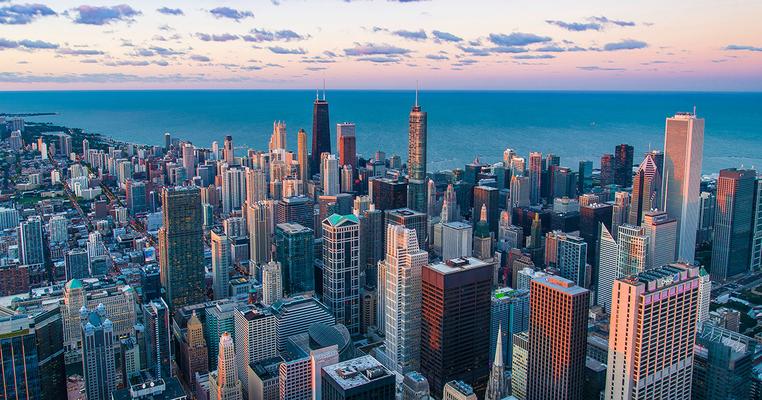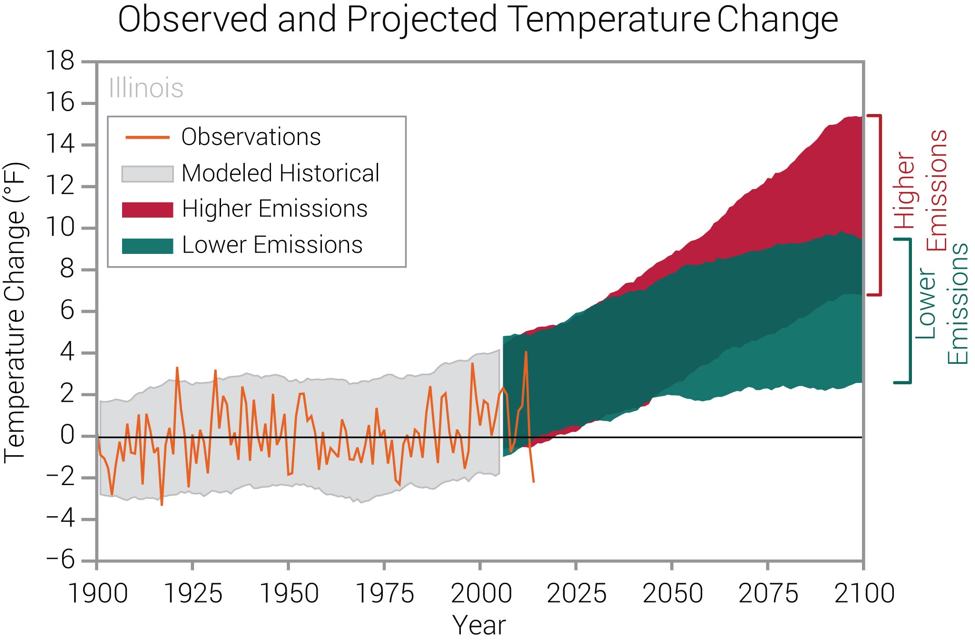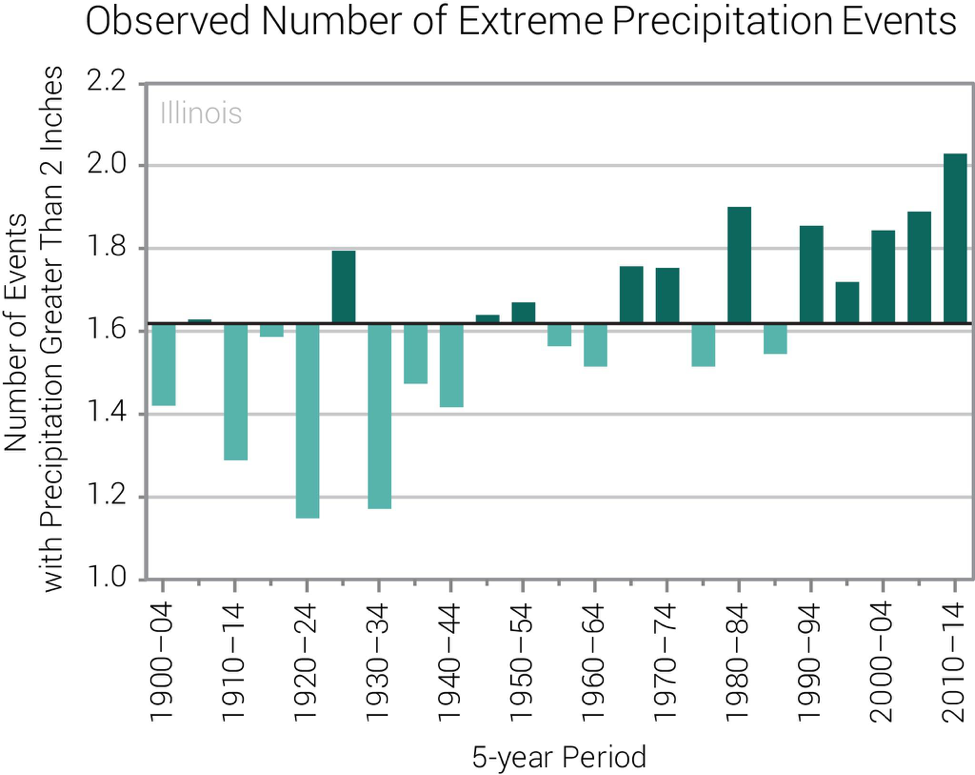
How Is the Climate Crisis Affecting Illinois?
Illinois is sometimes called the Land of Lincoln because our sixteenth president made the state his home. Today, nearly 13 million people also call Illinois home, and the impacts of climate change are becoming more and more clear where they live — from smaller communities like Alton and Mineral to the sprawling metropolis of Chicago.
Luckily, the state is taking action today. Governor JB Pritzker joined the US Climate Alliance within weeks of taking office in 2019 and has pushed hard for clean energy legislation in the state.
The potential switch to clean energy couldn’t come sooner for Illinois because it’s already experiencing higher temperatures, major flooding, a more volatile Lake Michigan, and more thanks to the climate crisis. Read on to get the facts.
Rising Temperatures
Here’s the climate reality: Since the early 1900s, the Land of Lincoln has warmed by about 1 degree Fahrenheit, on average. Without bold action to curb greenhouse gas emissions, the state could see “historically unprecedented” warming by the end of this century.
Illinois is known for both hot, muggy summers and bitterly cold winters — but the northern and southern parts of the state actually experience big differences in temperature, thanks to Lake Michigan’s moderating effect.
Average temperatures in Illinois and around the globe are climbing. Why? Overwhelmingly, this can be attributed to humans burning fossil fuels like coal, oil, and natural gas. Unlike renewable energy sources such as solar and wind, fossil fuels release greenhouse gases like carbon dioxide and methane into our atmosphere. These gases trap heat (like a greenhouse in your backyard) from escaping our planet and drive temperatures higher and higher, throwing our once-stable climate systems out of whack.

Observed and projected temperature rise in Illinois (courtesy of NOAA)
According to NOAA, much of the warming people in Illinois are experiencing is happening in the spring season, and “temperatures in the 2000s have been higher than any other historical period, with the exception of the early 1930s ‘Dust Bowl’ era.”
And without action, things are only expected to continue heating up.
By 2050, Climate Central estimates that Illinois could see 10 times as many dangerous heat days per year as it does today. It’s important to remember that extreme heat is more than just a nuisance: it can be extremely dangerous to our health, especially for vulnerable populations such as the elderly, outdoor workers, low-income families, and those experiencing homelessness. High temperatures – especially when combined with elevated humidity – can overwhelm the human body’s ability to regulate a safe internal temperature, resulting in heat exhaustion or even deadly heat stroke.
Chicago has already seen the tragic human toll of extreme temperatures — and with more frequent heatwaves expected with continued warming, it’s a stark reminder of what’s at stake if we don’t take action today.
Extreme Precipitation and Flooding
Here’s the climate reality: Extreme precipitation events in Illinois are rising dramatically thanks to climate change — which is directly linked to more powerful floods. This has serious implications for businesses, homes, and farming in the state.
There’s no two ways about it: 2019 was a hard year for Illinois and the rest of the Midwest. It was a year defined by extreme flooding (and heartbreak) across the region, especially for towns on the banks of the Mississippi River.
As Wired reported in June of last year, scientific models “warn that it’s going to get hotter, and that rain will continue to arrive in increasingly intense spring bursts, leaving long dry patches in the summer.” That’s because increasing temperatures are directly related to increasing precipitation — when it’s warmer than usual outside, more water evaporates from the Earth’s surface. Warm air also holds more water vapor, creating the perfect storm for more intense rain and snowfall.

“The observed number of days with extreme precipitation events (annual number of days with precipitation greater than 2 inches) for 1900–2014, averaged over 5-year periods.” (courtesy of NOAA)
In the Illinois community of Alton, “Mayor Brant Walker said the flood[ing] was so bad… that the river grew to 7 miles wide” and Alton’s damage was estimated at $3.65 million. Fifteen miles away in Grafton, the mayor lamented the impact of extended flooding on his town: “Before we considered it a nuisance. Now we’re going to lose businesses, and we’re going to lose homeowners.”
If homes and businesses weren’t enough, flooding hits farmers especially hard. It’s pretty simple: You can’t plant your crops in a flooded field. In June of 2019, CNBC reported that “James McCune, a farmer from Mineral, Illinois, was unable to plant 85 percent of his intended corn acres” thanks to the persistent heavy rains and record floods — and he’s just one of many farmers in the Midwest hit hard.
Climate change is making it more and more difficult for farmers to provide for their families — and to grow food for all of us. This is a startling look into what the future of food may hold without climate action.
“Seesawing” Great Lakes
Here’s the climate reality: Lake Michigan (along with the rest of the Great Lakes) is already being impacted by the climate crisis. Lake levels are becoming more volatile, causing damage to coastal economies.
As we reported in our blog covering climate impacts in the state of Michigan, “It’s like a seesaw. Between 1999 and 2014, lake levels were extremely low. But since then, communities near the lakes have experienced severe flooding and coastal erosion thanks to unusually high water levels on Lakes Michigan, Huron, and Superior.”
Illinois borders Lake Michigan on its northeast corner and Chicago sits right on its banks. The lake has risen six feet since 2013. To understand how big of a deal that is, consider this: because Lake Michigan is so huge, one inch of rise means about 790 billion more gallons of water. And that water can really pack a punch.
Coastal scientist Charles Shabica summed up what’s happening well in an article for NPR: “The... warmer atmosphere means more intense storms, and more intense storms mean large waves, and large waves mean more damage to structures along the shore.” In 2019, beaches across Chicago were pummeled — resulting in millions of dollars in damage. The city is already investing in concrete barriers to help protect lakefront property as Lake Michigan becomes more and more volatile with climate change.
And it’s not just physical climate risk — Illinois’ 63 miles of coastline on Lake Michigan contributes billions to the state's economy, from tourism and recreation to real estate and more.
Take Action Today
Whether you live in Illinois or not, you can take action to solve the climate crisis today. To learn how to get started, download our latest (free!) e-book, What Can You Do? Your Guide to Climate Action in 2020.
The impacts of the climate crisis may be far-reaching, but here’s the good news: solutions exist right now that can help us improve quality of life and work toward a more sustainable future for all of us.
And you are key to making those solutions a reality. Download this free new resource and learn how to shape climate action and drive change in your community today.

